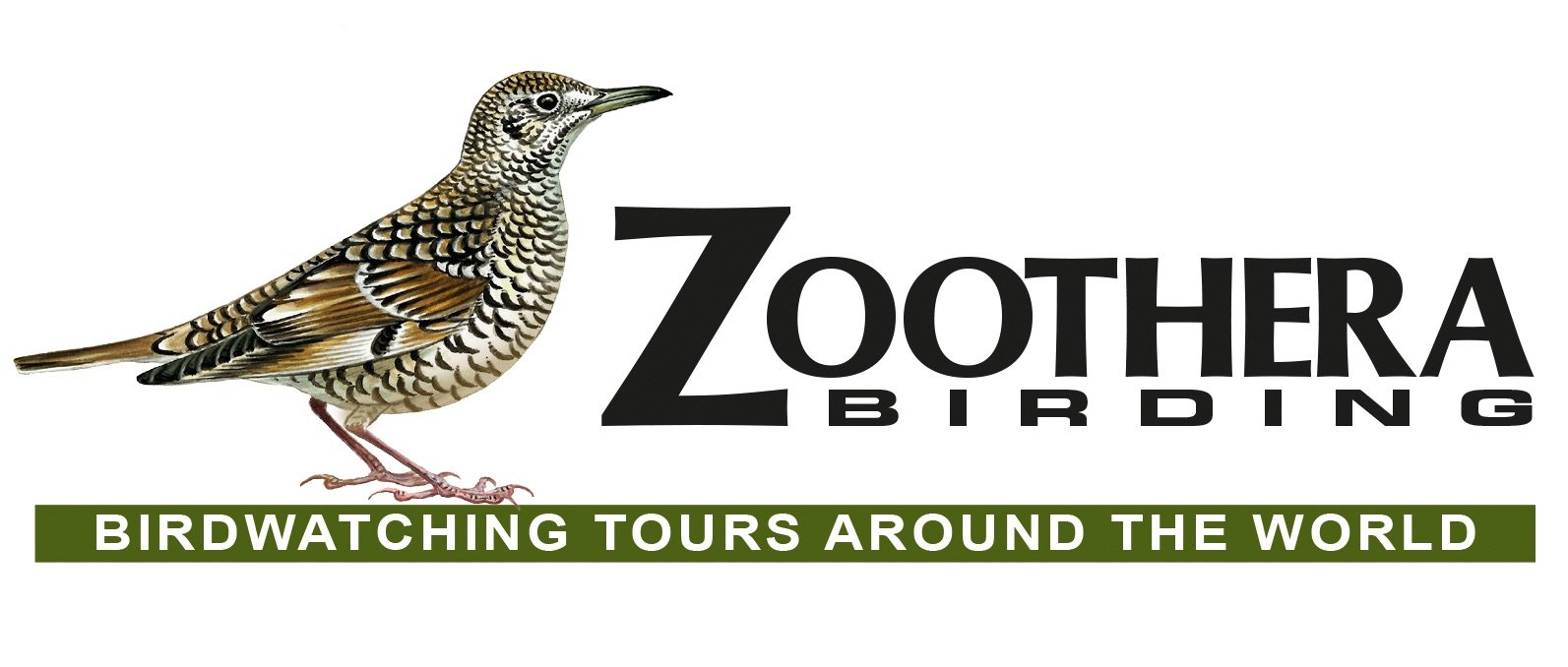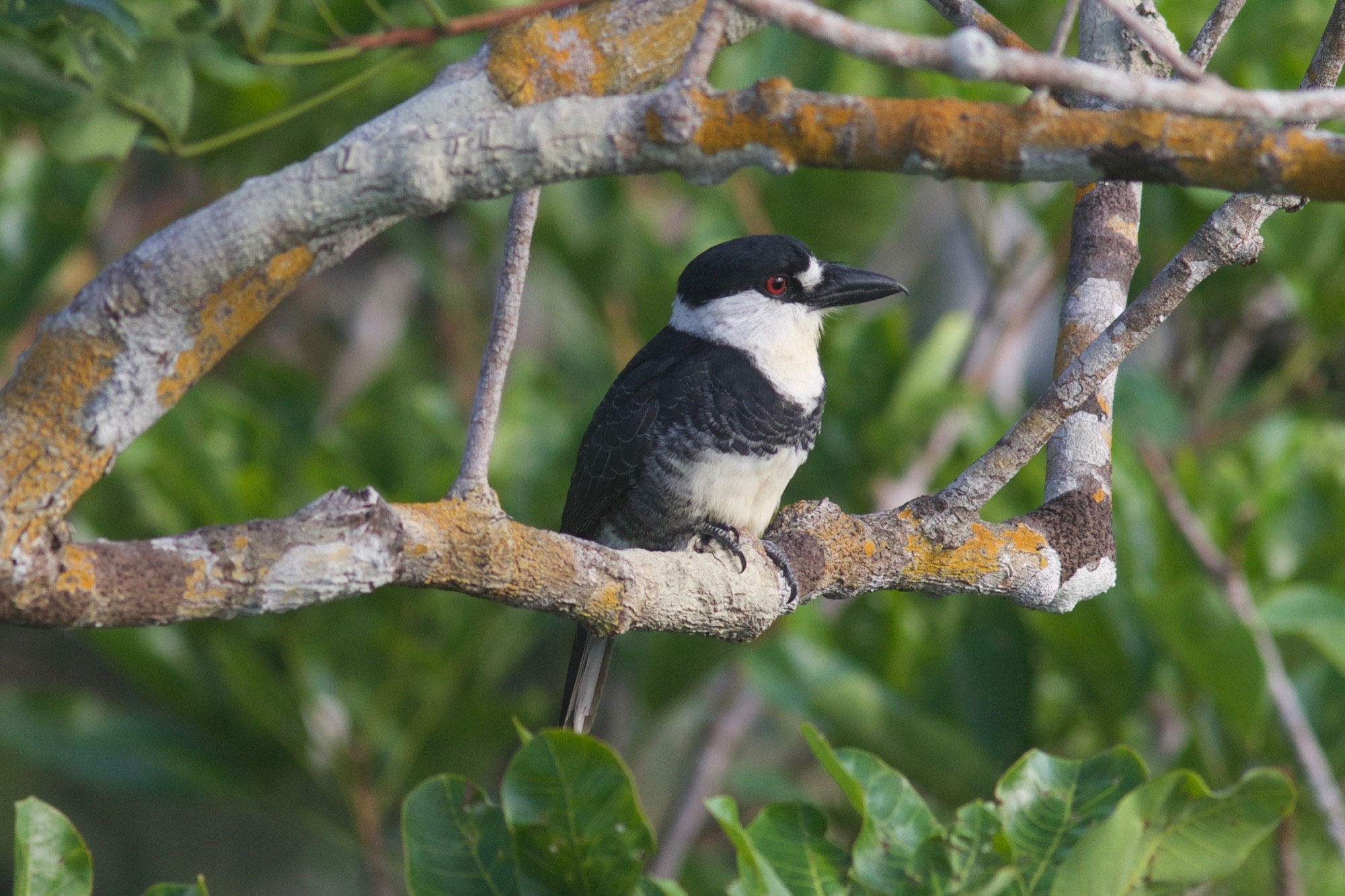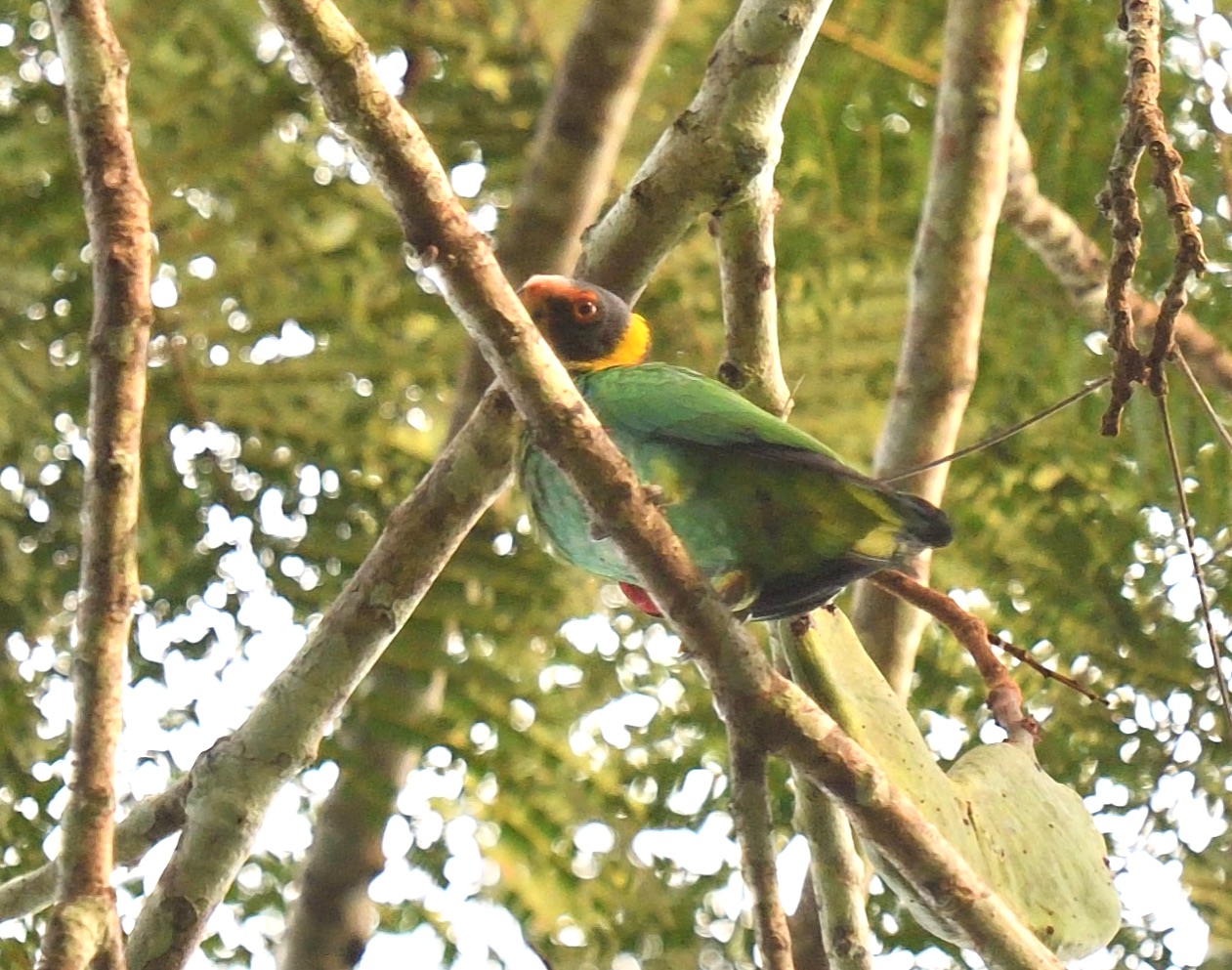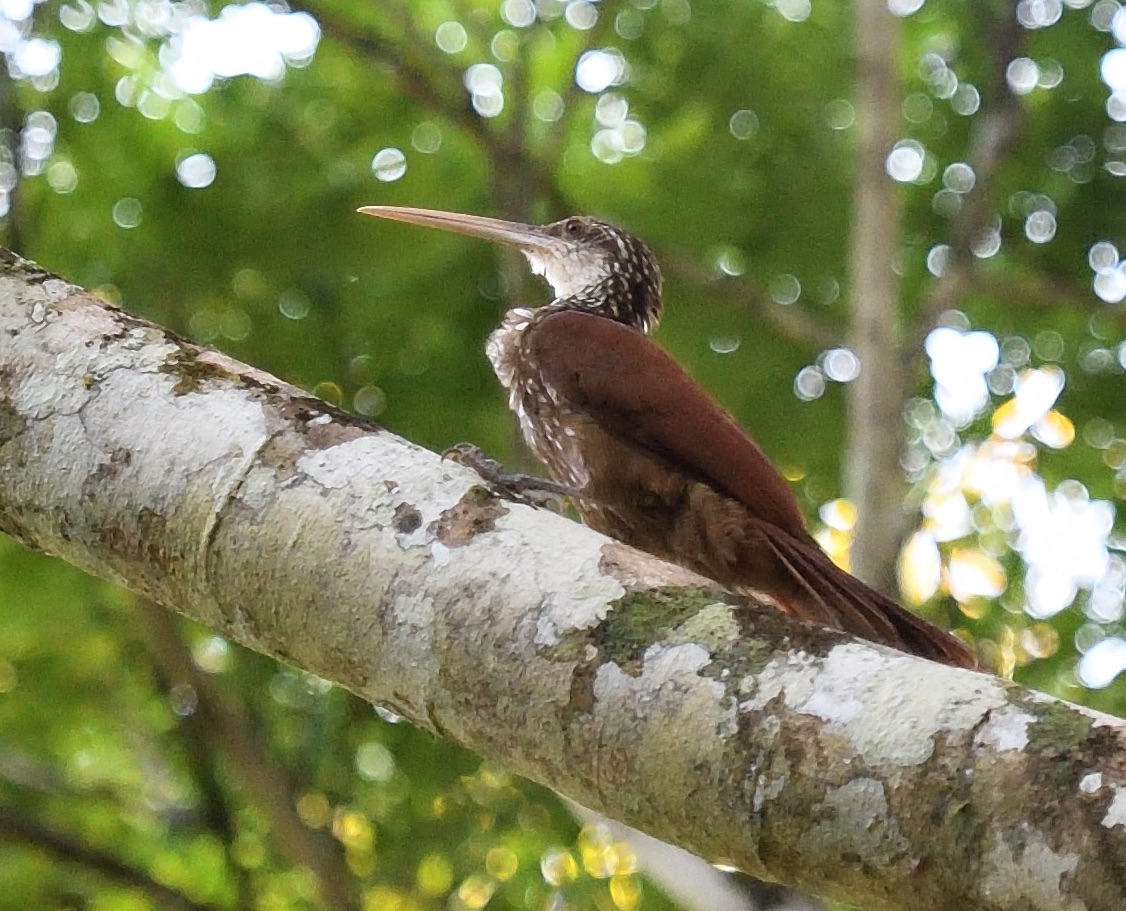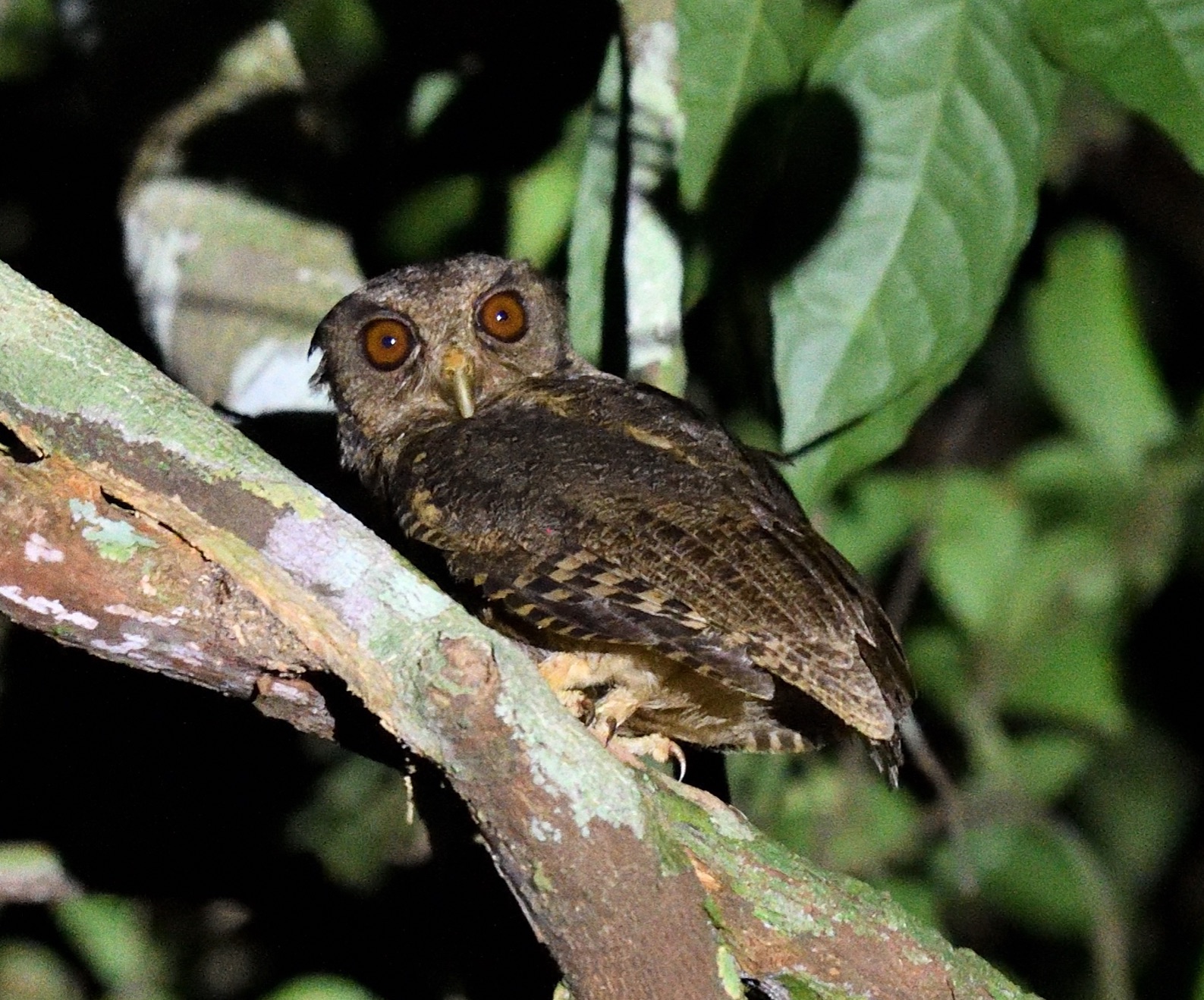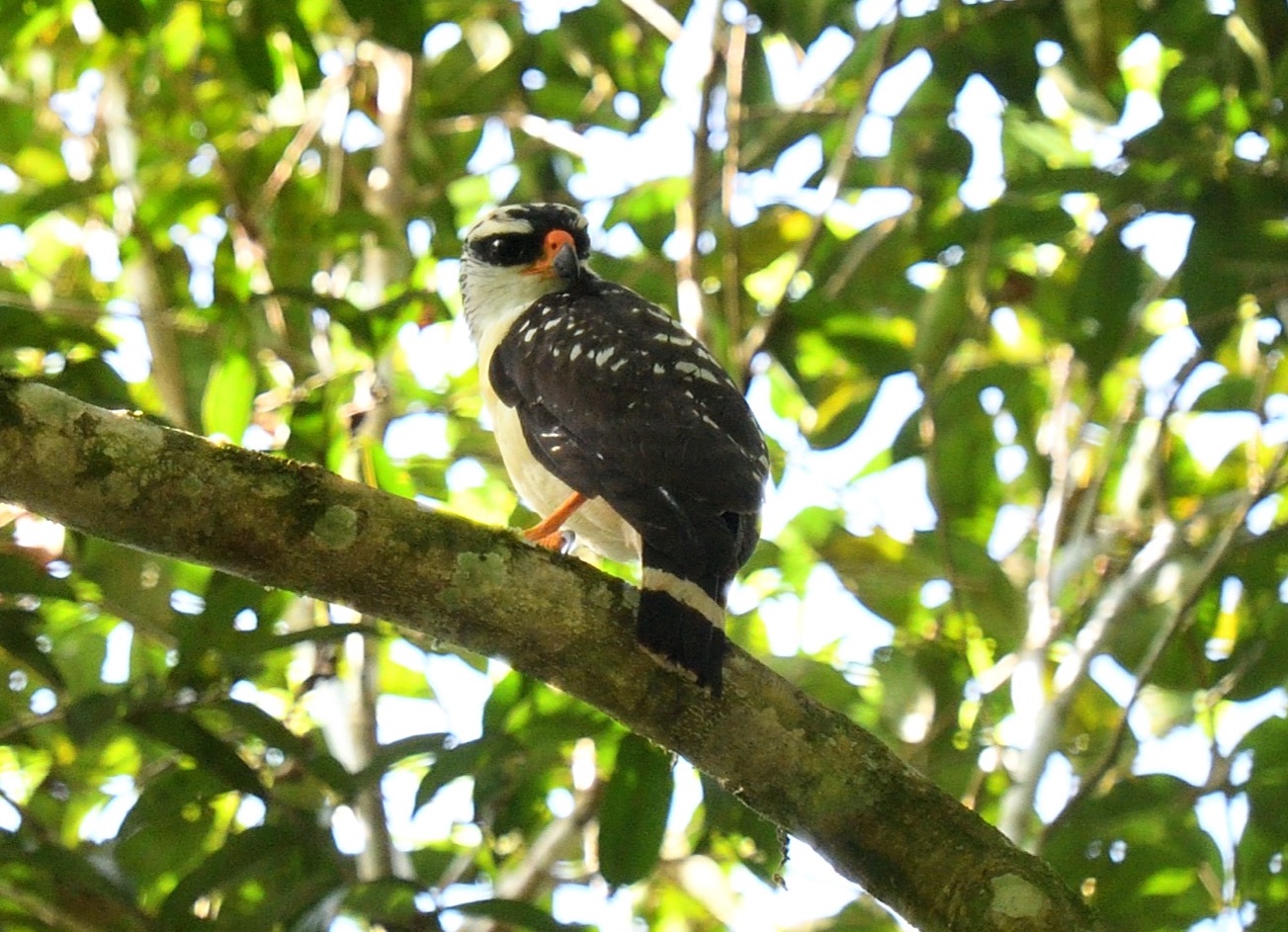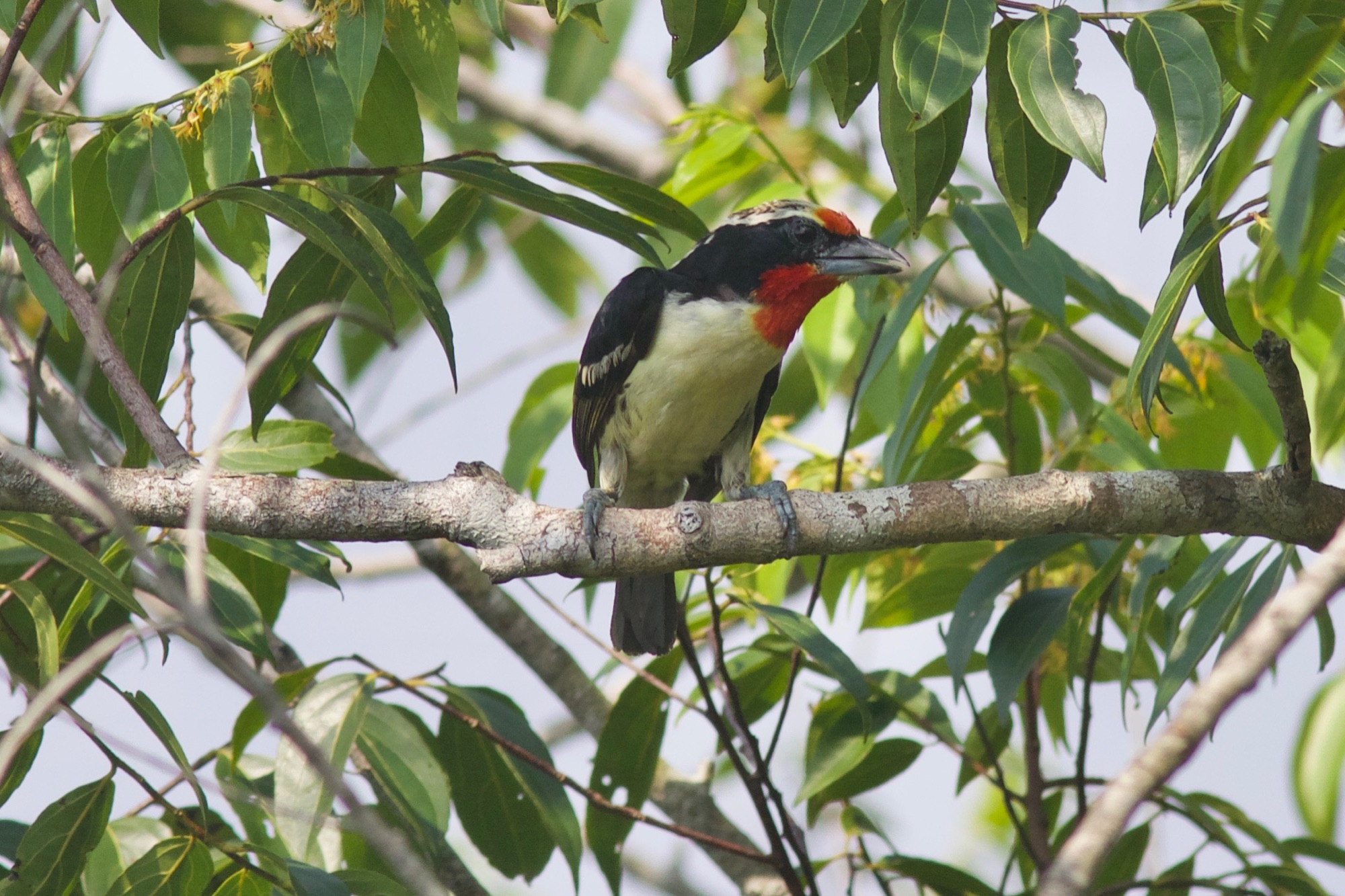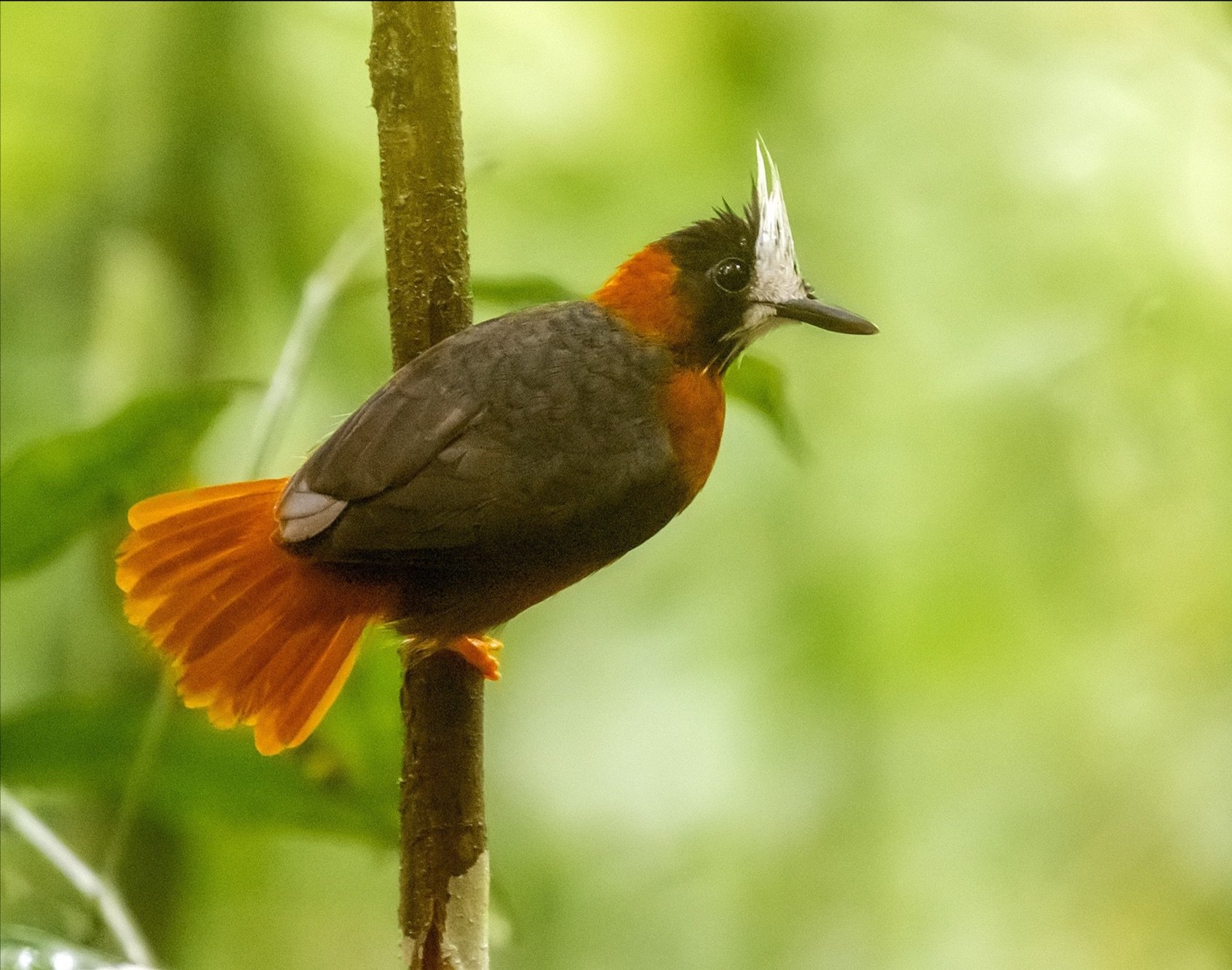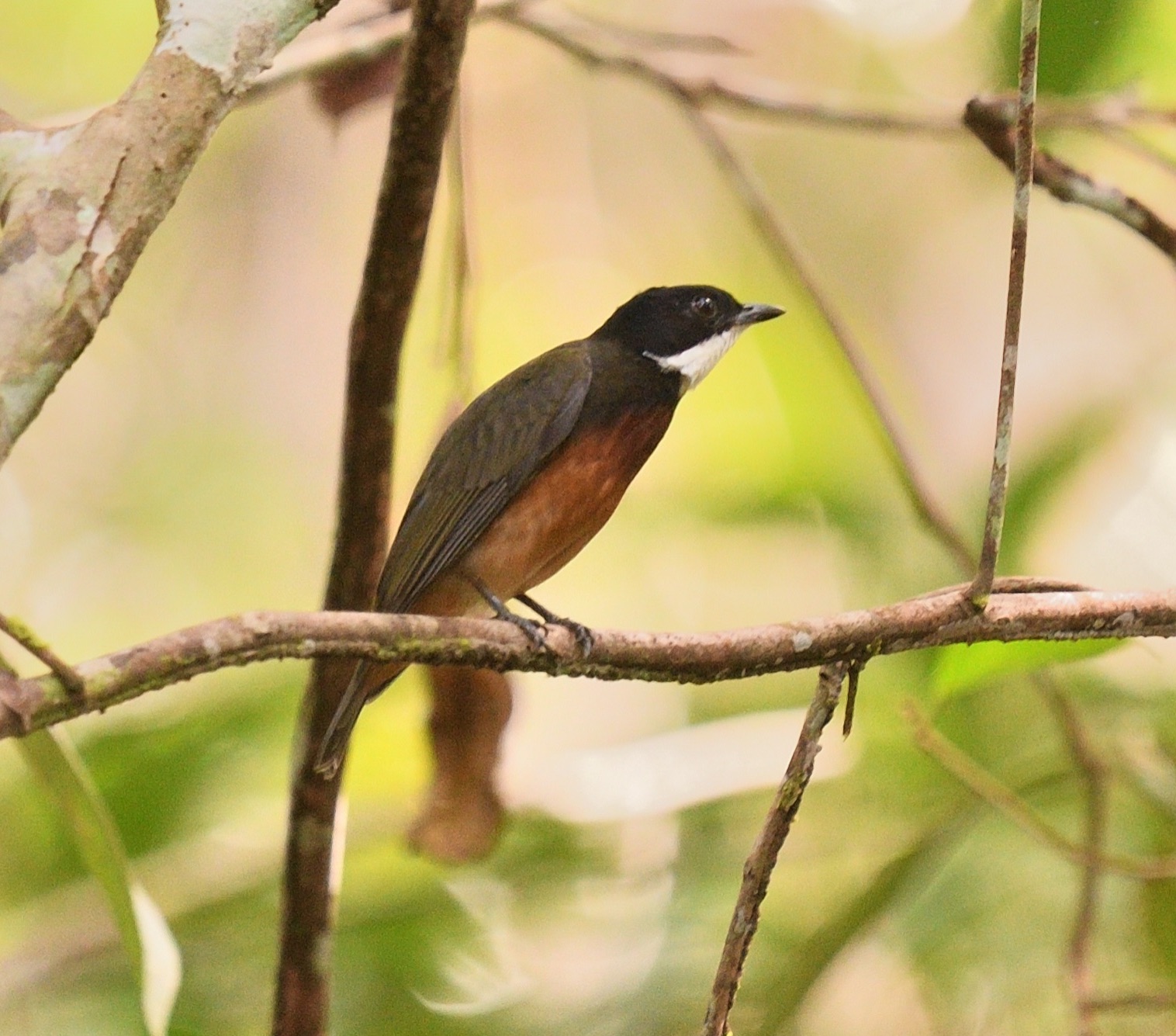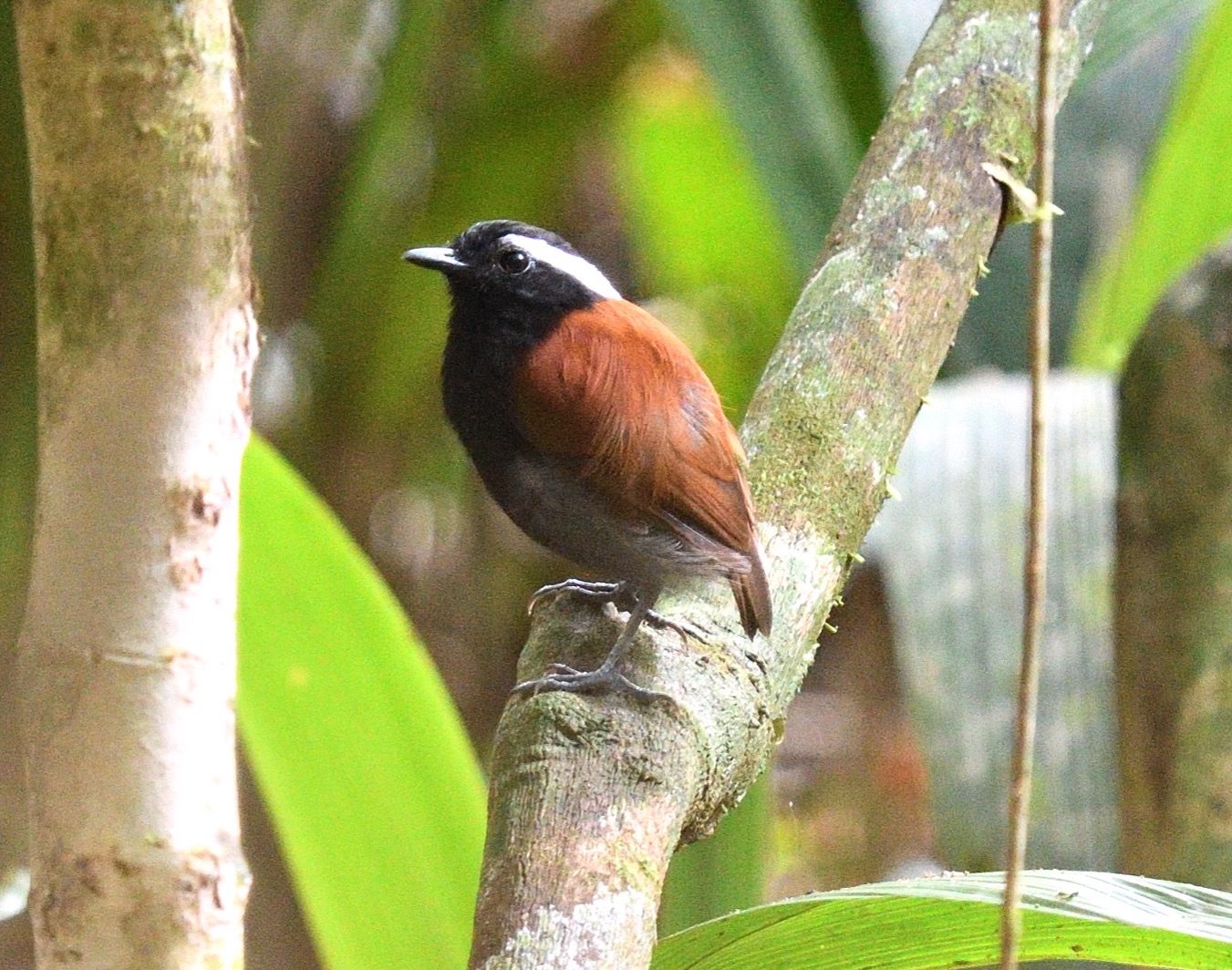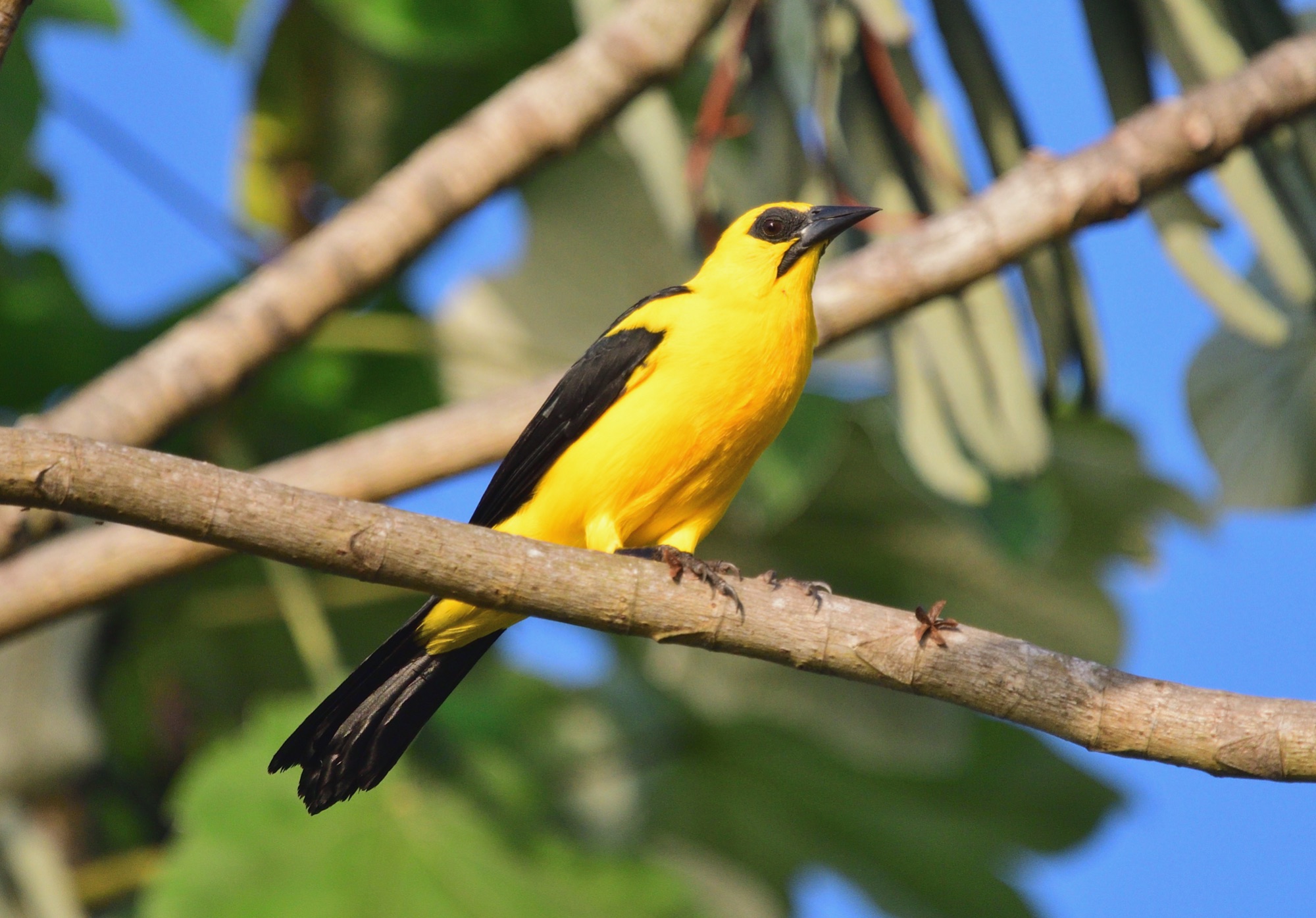Day 1 Arrival in Manaus - 15th July
Plan on arriving in Manaus, Brazil this morning before midday. After lunch we will head out into the forest for our first taste of birding. Night in Manaus.
Day 2 Manaus – Manacapuru
What better way to start our exciting Amazonian adventure than to spend the morning at the 42m high MUSA tower that gives unparalleled views from 3 different platforms staged at varying heights into the canopy. Some of the targets here include Caica and Red-fan Parrots, Channel-billed and White-throated Toucans, Green Aracari, Guianan Toucanet, Black-spotted Barbet, Waved Woodpecker, Guianan Puffbird, Spangled Cotinga, Glossy-backed Becard, Guianan Woodcreeper, Chapman's Swift, Yellow-throated Flycatcher, Painted Tody-Flycatcher, Red-billed Pied Tanager, Black-faced Dacnis and Spotted Tanager amongst others. We do expect to see flocks of macaws passing by and hopefully will observe several mixed-species feeding flocks leading us to us 'not knowing where to look first'.
In the afternoon we will drive around 20kms and visit Ramal do Pau Rosa, which is a good area to look for terre firme species such as Red-fan Parrot, Black-throated Antshrike, Northern Slaty-Antshrike, Black-throated and Dusky Antbirds and Blue-backed Tanager. And this area in general is really good for a few species that are much harder on the rest of our route such as Variable Chachalaca, Red-bellied Macaw, Blue-rumped Parrotlet, Gilded Barbet, Brown-banded Puffbird, Ivory-billed Aracari, Scale-breasted Woodpecker, Black-necked Red Cotinga, Yellow-browed and White-cheeked Antbird, Spotted Tody-Flycatcher, and Blue-crowned Manakin amongst others. Our great lodge is in an excellent location and there are bird feeders in the grounds attracting a variety of really cool birds and the photo opportunities are excellent. And hopefully, somewhere along our route today, there could be the added bonus of a Rufous Potoo as well! Night in Manacapuro.
Days 3 - 4 Manacapuru – Novo Airão – Anavilhanas National Park
As part of our exploration of the fabulous Manaus Amazonian region we will cross to the right margin of the Rio Negro river towards Novo Airão and begin exploring the west bank called the Imeri endemic centre, which offers a completely different suite of species. We will begin our morning birding in Balneário Cirandeira, where there is an easy access trail into the forest and this can be a great area that usually harbours some fruiting trees at this time of the year attracting a variety of cotingas and tanagers. Other species present along this trail include Gilded Barbet, Brown-winged Schiffornis, Yellow-browed and Common Scale-backed Antbird and sometimes Blue-crowned Manakin.
We will spend the afternoon closer to Novo Airão and the terra firme forest and islands of the amazing Anavilhanas National Park and what is known as the Igapó specialties. We may well spend all or part of the afternoon birding the piranha-laden, black waters of the Rio Negro from a boat (just 10 minutes from the hotel) to reach the myriad of inaccessible, forested islands and this will be a feature of our time here over the next day or so. Anazilhanas National Park has one of the largest fluvial archipelagos in the world and has more than 340 islands within its 350,000 hectares and the wider archipelago surrounding the Negro River covers an area of 100,000 hectares, dominated by Igapó, a forest that floods seasonally by black water that is relatively low in nutrients. This fantastic site is home to a seemingly endless list of species including Rusty Tinamou, Grey-winged Trumpeter, Marail Guan, Muscovy Duck, Agami Heron, Crested Eagle, Ornate Hawk-Eagle, Grey-headed Kite, Tiny Hawk, Red-throated Caracara, White-winged Potoo, Red-fan, Black-headed and Festive Parrots, Guianan and Tawny-tufted Toucanet, Bronzy Jacamar, Fiery-tailed Awlbill, Varzea Piculet, Pompadour Cotinga, White-chinned Swift, Guianan Puffbird, Amazonian Umbrellabird, Blackish-grey Antshrike, White-cheeked, Ash-breasted, Ferruginous-backed and White-plumed Antbirds, Leaden, Sclater’s, Cherrie's and the recently rediscovered endemic Klage's Antwren, Glossy-backed Becard, Guianan (Rio Negro) Gnatcatcher, Lesser Hornero, Red-billed and Ocellated Woodcreepers, Curve-billed Scythebill, Parker’s, Scaled Spinetail, enigmatic Zimmer’s and the more widespread Long-billed Woodcreepers, Varzea Schiffornis, Wing-banded Wren, Olive-green and Guianan Tyrannulets, Chestnut-belted Gnateater, Saffron-crested and Tiny Tyrant-Manakins, Bare-necked Fruitcrow, and Black, Yellow-crested and Wire-tailed Manakins, Golden-sided Euphonia, Blue-backed and Dotted Tanagers and poorly-known White-naped Seedeater. As dusk settles we can see flocks of Band-tailed Nighthawks, as well as Short-tailed Nighthawk. Rarer nightbirds we will try for include White-winged and Rufous Potoo, whilst Black-banded, Crested and Spectacled Owls are also possible.
We will also explore some trails and a dirt road that cuts through the tall forest along the west bank searching for army ant swarms that can 'pull out' the more secretive birds and if we are lucky enough to find a swarm we just won't know where to look first. Experiencing this natural phenomena is one of the avian wonders of the world as a seemingly quiet forest comes alive with the calls of a multitude of antbirds, antwrens and other ground-dwelling species. The stunning White-plumed Antbird is often seen at these swarms, along with the rare Reddish-winged Bare-eye, Pearly, Undulated and White-shouldered Antshrikes, Yellow-browed, Black-faced, White-cheeked, Spot-backed and Chestnut-crested Antbirds, Stipple-throated and Long-winged Antwrens, Rufous-capped Antthrush, Short-billed Leaftosser, and a myriad other birds with 'ant' in their name. We also hope to see Lined Forest-Falcon, Orange-cheeked and Dusky Parrots, Scarlet-shouldered Parrotlet, Ivory-billed Aracari, Tawny-tufted Toucanet (rare), Black-bellied Cuckoo, Great and Paradise Jacamars, Ruddy Quail-Dove, Straight-billed Hermit, Gilded Barbet, Red-necked and Scaly-breasted Woodpecker, Brown-banded Puffbird (rare), Duida (Lineated) and Ocellated Woodcreepers, Rufous-tailed Xenops, Grey Elaenia, Chestnut-belted Gnateater, Black-necked Red Cotinga, White-browed Purpletuft, Amazonian Royal Flycatcher, Collared Gnatwren, Dwarf Tyrant-Manakin, Yellow-crowned, White-crowned, Blue-crowned and Blue-backed Manakins, Rufous-bellied Euphonia, Short-billed Honeycreeper, Opal-rumped, Flame-crested, Spotted and Paradise Tanagers amongst many others. Nights in Novo Airão.
Day 5 Novo Airão - Manaus
We can spend the whole morning exploring some different trails for new species before heading back to Manaus. Birds here could include Streak-throated Hermit, Cream-coloured, Ringed and Yellow-throated Woodpeckers, Green-tailed Jacamar, Black-fronted Nunbird, Pygmy and Leadened Antwrens, Blackish-grey and Spot-winged Antshrikes, Black-chinned and Ash-breasted Antbirds, Straight-billed Woodcreeper, Speckled and Rusty-backed Spinetails, Snethlage's Tody-Tyrant, Amazonian Black Tyrant, Buff-breasted Wren, Grey-chested Greenlet, Turquoise Tanager and Orange-fronted Yellow-Finch. Night in Manaus.
Day 6 Marchantaria Island
This is going to be an exciting day as we will use boats to visit Marchantaria Island and a couple other smaller islands, which have the greatest diversity of bird species in the whole Amazon! High on our wish-lists will be island specialists such as Short-tailed Parrot, Brownish Elaenia, Black-and-white Antbird, River Tyrannulet, Riverside Tyrant, Lesser Hornero, Olive-spotted Hummingbird, Red-and-white and White-bellied Spinetail, the now rare endemic Scaled Spinetail, Castelnau's Antshrike, Pearly-breasted Conebill and many others. Other species here include Horned Screamer, Azure Gallinule, Hoatzin, Agami Heron, Slate-coloured Hawk, Slender-billed Kite, Collared Plover, Yellow-billed and Large-billed Terns, Ladder-tailed Nightjar, Tui Parakeet, Olive-spotted Hummingbird, Green-throated Mango, Castelnau's Antshrike, Black-and-white Antbird, Parker's, Rusty-backed, Dark-breasted and Pale-breasted Spinetails, Long-billed Woodcreeper, endemic Band-tailed Hornero, Chestnut-crowned Becard, Fuscous Flycatcher, Lesser Wagtail-Tyrant, Hooded and Orange-headed Tanagers, Orange-backed Troupial, Red-breasted Meadowlark, Wing-barred, Chestnut-bellied and Lined Seedeaters. There is also the possibility of finding the rare Zigzag Heron, although we would count ourselves extremely lucky indeed. Non-avian highlights could well include a glimpse of Pink River Dolphin, Grey River Dolphin (Tucuxi), Humboldt's White-faced Capuchin and Colombian Red Howler Monkey. Night in Manaus.
Day 7 Manaus - Presidente Figueredo
We will leave early on the road to Presidente Figueiredo and spend the morning at the famous ZF-2 Tower. From our vantage point some 40 meters above the ground we will be in a perfect spot for some canopy surprises! We will have chances for many canopy birds including birds that we might have missed in the MUSA Tower, such as the beautiful Crimson Fruitcrow, whilst seeing either Crested or Harpy Eagle would certainly make our day. Among a huge list of ptential species possoble here we hope to see Black-faced and White Hawks, Cryptic and Lined Forest-Falcons, Black-bellied Cuckoo, Red-lored Parrot (the diadema subspecies here is a certain split in the near future), Mealy and Dusky Parrots, Golden-winged Parakeet, both Racket-tailed Coquette and Rufous-throated Sapphire are possible if there are any flowering trees present nerby, Green Aracari, Amazonian Motmot, Black-tailed and Guianan Trogons, Scale-breasted and Golden-collared Woodpeckers, Black-spotted Barbet, Capuchinbird, Pompadour and Spangled Cotingas, Guianan Puffbird, Guianan Woodcreeper, Guianan Gnatcatcher, Ash-winged Antwren, Glossy-backed Becard, Painted Tody-Flycatcher, Guianan and Olive-green Tyrannulet, Slaty-capped Shrike-Vireo, Short-billed Honeycreeper, Green Oropendola, Moriche Oriole, and Red-billed Pied, Paradise, Spotted and the rare Dotted Tanager. There's also a good selection of primates in this area including Guianan Bearded Saki Monkey, Guianan Capuchin and Golden-handed Tamarin. Once we are finished here we will head to our base at Presidente Figueiredo where we will spend the next 3 nights.
Days 8 - 9 Presidente Figueiredo
The city of Presidente Figueiredo, 100km north of Manaus, has unique characteristics due to its rugged terrain and is a real paradise with over 50 waterfalls and is home to the spectacular Guianan Cock-of-the-Rock. One of the highlights of our stay here will be a visit to a lek of these amazing birds just a 15 minute walk away from our pousada. There are also several species in this region that reach the southernmost part of their distribution limits such as Painted Parakeet, White-breasted Wood-Wren and Dusky Purpletuft. We will also visit a white sand soil forest (locally known as campinarana) with its unique birds and is our best chance to see Green-tailed Goldenthroat, Bronzy Jacamar, Black Manakin, Pale-bellied Mourner, Northern Slaty-Antshrike, Pygmy Antwren, Short-billed Leaftosser, Rufous-crowned Elaenia and the emblematic Pelzeln's Tody-Tyrant.
There are a number of important sites to visit in the surrounding area such as Cachoeira da Onça, where our main targets will be Azure Gallinule, Hoatzin, Rufous Potoo, Pompadour Cotinga, the strange Capuchinbird, Guianan Red Cotinga, Cinereous Antshrike, Rufous-throated and Black-headed Antbirds, Musician Wren and Yellow-crowned Manakin amongst others. Cachoeira das Lages is good for Green-tailed Goldenthroat, Bronzy Jacamar, Black Manakin, Pale-bellied Mourner and White-naped Seedeater. Ramal do Mari-Mari is a terra firme forest and has a lek of Guianan Cock-of-the-Rock and a good chance of Yellow-crested Manakin. And this is a great place to see psittacids with numerous species of parrot possible in this area with Festive Amazon, Red-and-green Macaw, Sapphire-rumped and Scarlet-shouldered Parrotlets, Caica, Red-fan, Black-headed, Dusky, Orange-cheeked and Short-tailed Parrots, Golden-winged, Tui, Crimson-bellied and Santarem Parakeets all present.
Among the many other birds we might see in this area are Rusty, Grey and Variegated Tinamous, Little Chachalaca, Black Curassow, Horned Screamer, Dark-winged Trumpeter, Cayenne (Marial), Spix’s and White-crested Guans, Harpy Eagle, the recently split Amazonian Pygmy Owl, Gould’s and Guianan Toucanets, Crimson Topaz, Racket-tailed Coquette, Yellow-throated and Golden-collared Woodpeckers, Black-spotted and Brown-chested Barbets, Golden-spangled Piculet, Yellow-billed, Green-tailed and Paradise Jacamars, Amazonian Trogon, Purple-breasted Cotinga, Guianan Red-Cotinga, Chestnut-headed Nunlet, Guianan and Collared Puffbirds, Amazonian Umbrellabird, Screaming Piha, Spotted, Variegated and Alta Floresta Antpittas, Mouse-coloured, Castelnau’s, Glossy, Natterer’s Slaty, Saturnine and Spot-winged Antshrikes, Harlequin, Chestnut-crested Guianan Warbling, Xingu Scale-backed, Black-and-white, Willis’s, Rufous-faced, and Black-faced Antbirds, Brown-bellied, Leaden Pygmy, Spot-backed, Rufous-bellied, Ash-winged Antwren, Reddish-winged Bare-eye, Point-tailed Palmcreeper, Chestnut-rumped, Ocellated and Red-billed Woodcreepers, Scaled and White-bellied Spinetails, Guianan and Olive-green Tyrannulet, Sulphury Flycatcher, Guianan Gnateater, Cinnamon-crested Spadebill, Ringed Antpipit, White-eyed and Snethlage’s Tody-Tyrant, Short-tailed Pygmy-Tyrant, Painted Tody-Flycatcher, Cinnamon Manakin-Tyrant, Double-banded Pygmy-Tyrant, Wing-banded Wren, Tiny Tyrant-Manakin, Golden-headed, White-throated and White-fronted Manakins, Slaty-capped Shrike-Vireo, Brown-headed Greenlet, Pearly-breasted Conebill, Fulvous Shrike-Tanager, Opal-rumped, Paradise, Flame-crested, Red-billed Pied Tanager, Spotted, Red-shouldered and Fulvous-crested Tanagers, White-naped Seedeater and Yellow-green Grosbeak. Night birding excursions can be undertken for potoos, Blackish Nightjar, Black-banded Owl and Northern Tawny-bellied Screech-Owl. Nights in a lovely pousada near Presidente Figueiredo.
Day 10 Presidente Figuieredo – Manaus – End of Main Tour - 24th July
After some final birding we will transfer to Manaus airport for our international flights home this afternoon and end of the tour. For anyone continuing with the extension to Amazonia National Park, we will overnight at a hotel in Manaus.
************ AMAZONIA NATIONAL PARK EXTENSION *************
Day 11 Travel to Amazonia National Park - 25th July
This morning we will fly for around 80 minutes to Itaituba, where we will be picked up and transferred just over an hour to Pousada Portal Lodge, which is right beside the entrance to Amazonia National Park.
Days 12 - 14 Amazonia National Park
We have 3 full days to explore the numerous trails of the amazing Amazonia National Park. High on our wishlist are Vulturine Parrot and Golden Parakeet, both of which can be found in various areas here. Other key specialities include Dark-winged Trumpeter, White-crested Guan, White-browed Hawk, Cryptic Forest-Falcon, Fiery-tailed Awlbill, Amazonian Pygmy-Owl, Brown-chested Barbet, Hoffmanns's Woodcreeper, Harlequin, Xingu Scale-backed & Spix's Warbling Antbirds, White-eyed and Ornate Stipplethroats, Alta Floresta and Amazonian Antpitta, Black-bellied Gnateater, Rufous-necked and Collared Puffbirds, White-tailed Cotinga, Rose-breasted Chat and Flame-crowned Manakin.
A fine supporting cast includes Speckled Chachalaca, Razor-billed Curassow, Black Caracara, Tropical and Tawny-bellied Screech-Owls, Spectaclecd Owl, Blue-headed Parrot, Southern Mealy Amazon, Santarem Parakeet, Scarlet Macaw, Short-tailed and Sand-coloured Nighthawks, Gould's Toucanet, Black-necked & Red-necked Aracari, Crimson-crested, Yellow-tufted & Red-stained Woodpeckers, Great Jacamar, Broad-billed & Rufous Motmots, Amazonian Trogon, Dark-billed Cuckoo, White-banded and Black-collared Swallows, Spot-winged, Natterer's Slaty, Saturnine & Amazonian Antshrike, Spix's Warbling Antbird, Amazonian Streaked Antwren, Black-spotted Bare-eye, Rusty-belted Tapaculo, Hauxwell's Thrush, Bare-necked Fruitcrow, Moustached Wren, Red-headed & Snow-capped Manakins, Olive Oropendola and so much more!
Day 15 Amazonia National Park - Manaus - 29th July
We will have a final morning's birding before setting off back to Itaituba Airport after lunch for the short flight back to Manaus where the tour concludes upon arrival.
